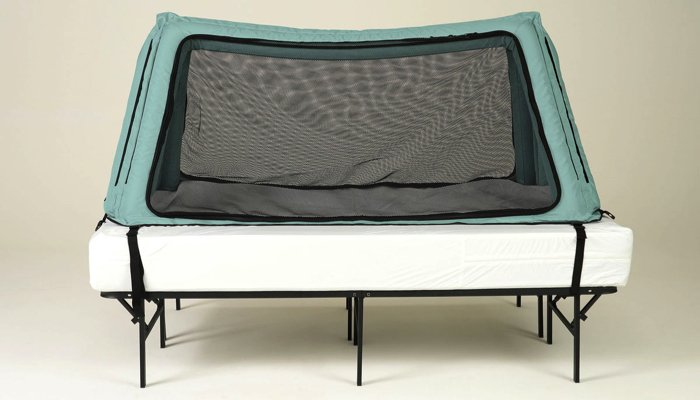Sleep Training Methods for Your Baby: The Top 5 Explained

This post may contain affiliate links; please see our terms of use for details.
If you’re a new parent, you’re probably exhausted and desperate for a good night’s sleep. Babies often love to be rocked, cuddled, or nursed to sleep. And while you may enjoy this precious time with your newborn, it isn’t exactly conducive to restful sleep for you.
The good news is that by around 4 to 6 months old, most babies are physically and developmentally ready for sleep training. Sleep training can mean a more consistent routine and longer stretches of sleep, which is essential for your and your baby’s overall health.
But where do you begin? There are so many baby sleep training methods and drastically differing opinions on sleep training out there, and many parents aren’t sure what the “right” way to sleep train is or if they should do it at all. Some sleep training methods involve letting your baby cry so they learn to soothe themselves to sleep, but there are also more gentle sleep training methods.
There are many different approaches to sleep training, but the right option is the one that works for your family, your baby, and your overall parenting approach. Here are some of the most popular sleep training methods, including two “no cry” approaches to sleep training.
The Ferber Method
There are many misconceptions about using the Ferber Method, but it’s actually very gentle when done correctly.
The Ferber method is one of the most popular forms of sleep training but is sometimes associated with “cry-it-out” or “graduated extinction.” However, Dr. Richard Ferber developed this form of sleep training in response to his observations that many babies who were not helped by traditional methods had deep problems with sleeping due to separation anxiety (from being left alone).
This approach teaches babies how to fall asleep on their own and return to sleep when they wake up during the night. The goal is for the baby’s parents (and other caregivers) to provide comfort without picking them up or feeding them until they stop crying. Once they stop crying, they’re allowed into bed with their caretaker.
Common Concerns About the Ferber Method
“I can’t leave my baby to cry!”
One major misconception about the Ferber method is that it’s intended for babies of all ages and stages—but it’s not. If your baby still requires night feedings or scheduled feedings, it’s too soon to try Ferber.
“It could affect my baby in a negative way later in life.”
It’s important to note that this form of sleep training is meant to be supportive as your baby learns good sleep habits, and it’s not a form of punishment. The goal of the Ferber method isn’t to make your baby cry. In fact, Dr. Ferber has even said himself, “I never meant for parents to let a child scream itself awake.”
“What if the crying makes me miss signs that my child is sick?”
The Ferber method starts slowly and gradually, not all at once. Of course, if you feel your baby might be sick, supporting them during recovery is your first priority, and sleep training can wait.
“My child will be afraid of sleeping on their own when they wake up at night.”
The Ferber method only lasts a few days or weeks at most, which is not long enough to create any lasting trauma. However, this method is not intended for children that struggle with anxiety or other diagnosed disorders.
This approach has shown to be beneficial for many parents. However, it may not be ideal for everyone. You know your baby better than anyone, so it’s important to weigh the options carefully before deciding on this or any other sleep training method!

The Cry It Out (CIO) Method
The CIO method is an overarching term that includes several methods that allow babies to cry for a set amount of time as they learn to fall asleep on their own. Of all the sleep training methods, the Cry it Out (CIO) method conjures up especially strong emotions and arguments among parents, pediatricians, and psychologists.
Similar to the Ferber method, the idea of the CIO method is that it will teach your baby to go to sleep without needing any help from you. Infants often like to be rocked or nursed to sleep, and will initially cry if you try to put them to sleep without cuddling or rocking them. With the CIO method, parents allow their baby to cry until they learn to soothe themselves to sleep.
Parents can approach the CIO method in different ways. Some may choose not to interfere with crying at all, which can be a quick sleep training method for some babies. Other parents find listening to their baby’s cries too difficult and will comfort their baby at intervals.
Common Concerns About the CIO Method
The biggest, fear-triggering concern is that the CIO method may harm babies physically or emotionally. Research is inconclusive on whether this approach has any negative long-term effects on babies. Some research, however, shows that it’s safe for most babies.
- One study found no signs of adverse effects in infants left to “cry it out” at 18 months old.
- A long-term study involving 200 families concluded that there were no detrimental effects on the children’s sleep patterns, behavior, or relationship with their parents after using the CIO method.
- Babies were reported to stay asleep longer with few wakings throughout the night using the CIO method.
If the CIO Method sounds like a good choice for you and your baby, you can do a quick screening before you proceed. Ask yourself:
- Does your baby have a health condition?
Once the pediatrician has ruled out any health concerns, such as acid reflux, bring up your sleep training plans—specifically mentioning the CIO Method—and see if the pediatrician gives you the green light.
- Are YOU ready?
It’ll take some grit on your part, dear parent. There are few things that are more heart-wrenching and excruciating than your baby’s cries. You’ll need to decide on a sleep plan, brace yourself, and stick to the plan.
The Chair Method
The chair method is a gentle and effective sleep training method that’s more gradual in its approach than other sleep training strategies. Some parents prefer the chair method to the Ferber method or CIO because it allows you to be present in the room with your baby and to reassure them if they cry or fuss. But like the other methods, it takes time, patience, and consistency.
How to use the Chair Method
Here’s how the chair method is done:
- Place a chair right next to your baby’s crib.
- Get your baby ready for bed according to your usual bedtime routine.
- Lay your baby down while they’re still awake.
- Sit in the chair next to the crib until they fall asleep.
- Leave the room.
- If your baby wakes up or cries, go back into the room and sit in the chair again. You can gently “shhh” to comfort and soothe your baby or pat them. But avoid talking and too much eye contact as this can overstimulate your baby. While sitting in the chair, remain calm and still so that your baby understands that you’re not there to play or be active with them.
- Once they’re asleep, you can leave the room. Repeat as necessary.
Every few nights, move the chair farther away from the crib. Repeat the steps as necessary each night. Keep moving the chair until you have reached the doorway to your baby’s room. You can continue to reassure your baby if you think they need it but try to do so less and less each time you move the chair.
After about 10 to 14 days, your chair should be just outside the room, but still in view of your baby. By this time, your baby should be able to settle down to sleep on its own.
This method can be used with babies from 4 to 6 months old and is good for babies who find their parents’ presence at bedtime calming and soothing rather than stimulating.

No Cry Sleep Training Methods
Not all sleep training has to involve letting your baby cry. As parents, we all hope that our babies will learn to fall asleep on their own eventually, but it can be tough to listen to your infant’s cries. And some parents also feel that they shouldn’t let their baby cry to sleep, since crying is how they communicate their needs.
Whatever the reason, if you don’t like the idea of letting your baby cry at night, there are other options you can try. The Fading method and the Pick Up, Put Down method are two popular gentle sleep training methods to consider that don’t involve any crying.
The Fading Method
Sometimes called Fade It Out (FIO), the Fading sleep training method is a milder alternative to other sleep training techniques. In this gentle approach, your ideal bedtime routine gradually replaces your current bedtime struggle. It might take a little more time, but with considerably less crying. There are three different approaches, so you can find what works best for you and your baby.
Routine Fading
Begin with whatever your normal routine is for getting baby to sleep—rocking, nursing, singing, bouncing, or a combination. This way, you can still provide your baby the comfort they’re used to. You’ll just be spending a little less time on it each night until it’s no longer needed.
Bedtime Fading
Start by noting the time your baby actually falls asleep most nights. Make that time your baby’s bedtime—for now. Then move the whole bedtime routine up a little earlier each night, in 15-minute increments, until baby falls asleep at the ideal bedtime.
Caregiver Fading
By reducing how much time you’re in the room, your baby slowly gets used to falling asleep without you. There are two ways you can do this.
One option is to stay in the room to comfort your baby if they fuss, but move a little further away every night. Eventually, you won’t need to be in the room at all. Or, leave the room but check in with them at set times—every 5 minutes to start. Increase the time you’re gone until you don’t need to check in anymore.
The FIO method works well with babies between 4 and 6 months old. It will take a lot of repetition and commitment on your part. But if it’s not possible to comfort your baby every time they wake during the night, and you want to take sleep training slowly, give the fading method a try.
The Pick Up, Put Down Method
Another gentle approach to sleep training is the Pick Up, Put Down method. This method aims to help your baby learn to fall asleep while still ensuring that they know you’re there with them. This sleep training method works best for babies between 4 and 8 months old.
How to use the Pick Up, Put Down Method
After your put your baby in their crib for bedtime, follow these steps:
1. Wait. If your baby starts to cry, stop and wait for a moment. Listen to see if they can calm themselves. Sometimes your baby might surprise you and self soothe.
2. Comfort. If your little one doesn’t settle, try placing your hand on their tummy and gently shushing. This may be enough to calm them and is why this technique is sometimes known as the Shush-Pat method.
3. Pick Up. If your voice and touch are not enough, pick them up for a cuddle.
4. Put Down. The second your baby stops crying, put them down. You must place them on the mattress even if they start crying again on the way back down. Leave your hand on their tummy and speak softly, to reassure them that you’re there.
5. Keep Going. It takes an average of 20 minutes for a baby to fall asleep with the Pick Up, Put Down method. However, it can take much longer at first, even more than an hour. Tracy Hogg, author of Top Tips from the Baby Whisperer, found she had to use it with some babies 100 times!
6. Leave the room. Once your baby settles, stay with them, resting your hand on their tummy. When they’re in a deep sleep, leave the room.
Does the Pick Up, Put Down Method Work?
Every baby is different and their stage of development will have a big impact on success. Your baby might find it too stimulating to be repeatedly picked up. If so, think about trying a different sleep training program.
Final Thoughts
There is no one right way to sleep train a baby. It all depends on your child’s temperament, your lifestyle, and your own beliefs about parenting. If you still aren’t sure which method is right for you, you can always discuss sleep training with your child’s pediatrician. Some parents will even try more than one approach. Just remember that, eventually, you and your baby will both sleep well at night.

Related Posts

Sleep, Special Needs
Safe Place Bedding Travel Bed Review
Traveling with a special needs child can be stressful! Having a safe, durable, and easy to use travel bed can make traveling so much easier!

Sleep, Special Needs
Sleep Regimen for Premature Babies: Special Considerations
It can take premature babies much longer than their full-term peers to sleep for long stretches. A preemie sleep schedule may encourage better sleep.

Sleep
Mastering the Bedtime Routine: 3 Tips for a Peaceful Night’s Sleep
From around six weeks, a newborn bedtime routine can help your baby learn the difference between day and night and prepare for a restful night’s sleep.